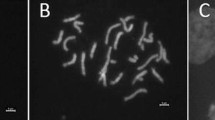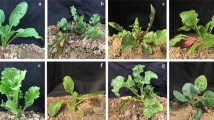Abstract
The genus Asparagus (Asparagaceae) encompasses 100–300 species, including the important vegetable crop, A. officinalis (garden asparagus). Previous attempts to hybridize garden asparagus with A. densiflorus (Kunth) Jessop, with the aim of introducing disease resistance, were unsuccessful because of the failure of endosperm development. In the present study, reciprocal interspecific hybrids between garden asparagus and A. schoberioides Kunth were generated by hand pollination. The F1 hybrids were analyzed by using both morphological and molecular techniques. This is the first report describing the production of an interspecific hybrid between garden asparagus at the diploid level (2n = 2x = 20) and its diploid (2n = 2x = 20) wild relative, A. schoberioides. Morphological characteristics of candidate hybrids were a mixture of those found in the parents, and cytological and RFLP analyses confirmed that morphologically intermediate plants were indeed diploid hybrids of those two species. In other words, post-zygotic isolation is not complete between phylogenetically distinct these two species. Our results suggest that other Asparagus species may be capable of hybridizing with A. officinalis and that introducing wild characters through interspecific hybridization may offer advantages for breeding for novel traits.
Similar content being viewed by others
References
Bailey LH (1944) Asparagus. In: Bailey LH (ed) The standard cyclopedia of horticulture. The Macmillan Company, New York, pp 406–411
Chen X, Tamanian KG (2000) Asparagus. In: Wu Z, Raven PH (eds) Flora of China, vol 24 (Flagellariaceae through Marantaceae). Science Press, Beijing, and Missouri Botanical Garden Press, St. Louis, pp 139–146
Chittenden FJ (1956) Asparagus. In: Chittenden FJ (ed) Dictionary of gardening. Clarendon Press, Oxford, pp 193–196
Clifford HT, Conran JG (1987) Asparagaceae. In: George AS (ed) Flora of Australia. Australian Government Publishing Service, Canberra, pp 159–164
Coyne JA, Orr HA (1989a) Patterns of speciation in Drosophila. Evolution 43:362–381
Coyne JA, Orr HA (1989b) Two roles of speciation. In: Otte D, Endler JA (eds) Speciation and its consequence. Sinauer Associates, Sunderland MA, pp 180–207
Coyne JA, Orr HA (1997). Patterns of speciation in Drosophila’ revisited. Evolution 51:295–303
Dahlgren RMT, Clifford HT, Yeo PF (1985) Asparagaceae. In: Dahlgren RMT, Clifford HT, Yeo PF (eds) The families of the monocotyledons. Springer-Verlag, Berlin, pp 140–142
Ellison JH (1986) Asparagus breeding. In: Basset MJ (ed) Breeding vegetable crops. AVI Publishing Company Inc., Westport, pp 521–569
Endo RM, Burkholder EC (1971) The association of Fusarium moniliforme with the crown rot complex of asparagus. Phytopathology 61:891
Fukuda T, Ashizawa H, Suzuki R, Nakamura T, Ochiai T, Kanno A, Kameya T, Yokoyama J (2005) Molecular phylogeny of the genus Asparagus (Asparagaceae) inferred from plastid petB intron and petD-rpoA intergenic spacer sequences. Plant Species Biol 20:121–132
Hiratsuka J, Shimada H, Whittier R, Ishibashi T, Sakamoto M, Mori M, Kondo C, Honji Y, Sun CR, Meng BY, Li YQ, Kanno A, Nishizawa Y, Hirai A, Shinozaki K, Sugiura M (1989) The complete sequence of the rice Oryza sativa chloroplast genome: intermolecular recombination between distinct transfer RNA genes accounts for the major plastic DNA inversion during the evolution of the cereals. Mol Gen Genet 217:185–194
Kanno A, Kameya T (1999) Cloning and variation of ribosomal DNA from Asparagus officinalis L. Acta Hort 479:365–372
Kar DK, Sen S (1985) Chromosome characteristics of Asparagus-Sapogenin yielding plant. Cytologia 50:147–155
Komarov VL (1968) Asparagus L. In: Komarov VL (ed) Flora of the USSR, vol IV. Israel Program for Scientific Translations, Jerusalem, pp 325–339
Kubituki K, Rudall PJ (1998) Asparagaceae. In: Kubituki K (ed) The families and genera of vascular plants, vol 3. Springer-Verlag, Berlin Heidelberg, pp 125–128
Lee Y-O, Kanno A, Kameya T (1997) Phylogenetic relationships in the genus Asparagus based on the restriction enzyme analysis of the chloroplast DNA. Breed Sci 47:375–378
Marcellán ON, Camadro EL (1996) Self- and cross-incompatibility in Asparagus officinalis and Asparagus densiflorus cv. Sprengeri Can J Bot 74:1621–1625
Marcellán ON, Camadro EL (1999) Formation and development of embryo and endosperm in intra- and inter-specific cross of Asparagus officinalis and A.␣densiflorus cv. Sprengeri Sci Hort 81:1–11
Namba T (1993) The encyclopedia of Wakan-Yaku (Traditional Sino-Japanese Medicines) with color pictures vol I, new completely revised edition. Hoikusha Publishing Co, Ltd, Osaka, pp 33–34
Ochiai T, Sonoda T, Kanno A, Kameya T (2002) Interspecific hybrids between Asparagus schoberioides Kunth and A. officinalis L. Acta Hort 589:225–229
Ohwi J (1965) Asparagus L. In: Meyer FG, Walker EH (eds) Flora of Japan. Smithsonian Institution, Washington DC, p 300
Stajner N, Bohance B, Javornik B (2002) Genetic variability of economically important Asparagus species as revealed by genome size analysis and rDNA ITS polymorphisms. Plant Sci 162:931–937
Valdes B (1964) Asparagus L. In: Tutin TG, Heywood VH, Burges NA, Moore DM, Valentine DH, Walters SM, Webb DA (eds) Flora Europaea. Cambridge University Press, Cambridge, pp 71–73
Acknowledgments
We wish to thank, Y. Hayashi, J.-H. Park, H. Saeki, P.-Y. Yun, B.-J. Park, H. Hienuki, R. Miura, T. Nakamura, I.-J. Song, Y. Mashiko, M. Nakada, R. Shinohara, M. Komatsu, N. Kuroiwa, T. Shishido, S.-Y. Kim, M. Hirai, T. Kamimura, H. Nakayama and H. Tokairin for providing much help and advice. This study was partly supported by a Grant from Itoh Science Foundation and Research Promotion for the Graduate School of Life Sciences, Tohoku University.
Author information
Authors and Affiliations
Corresponding author
Additional information
Takuro Ito and Toshinori Ochiai authors are contributed equally to this work
Rights and permissions
About this article
Cite this article
Ito, T., Ochiai, T., Ashizawa, H. et al. Production and analysis of reciprocal hybrids between Asparagus officinalis L. and A. schoberioides Kunth. Genet Resour Crop Evol 54, 1063–1071 (2007). https://doi.org/10.1007/s10722-006-9186-1
Published:
Issue Date:
DOI: https://doi.org/10.1007/s10722-006-9186-1




